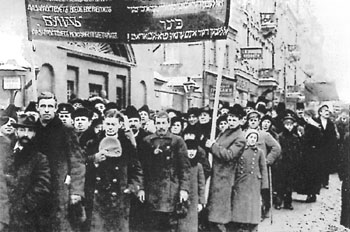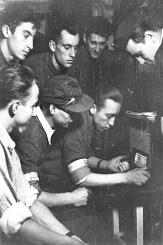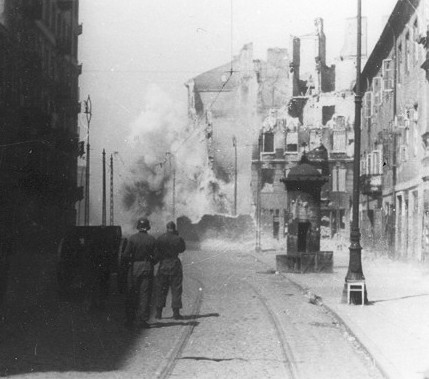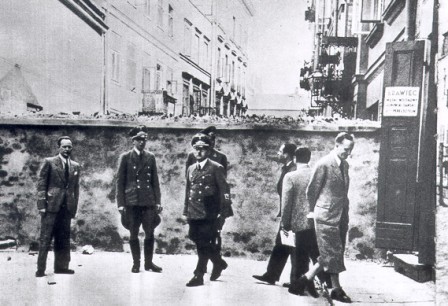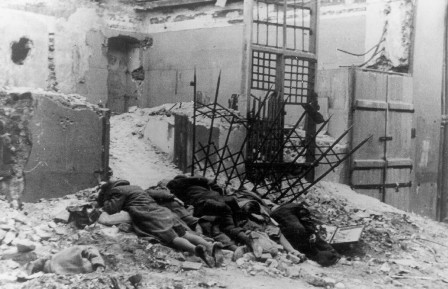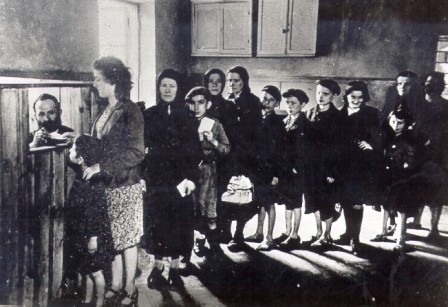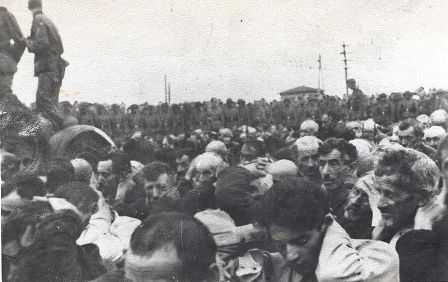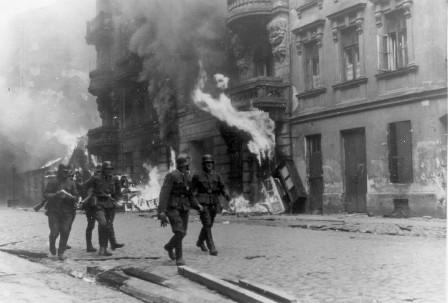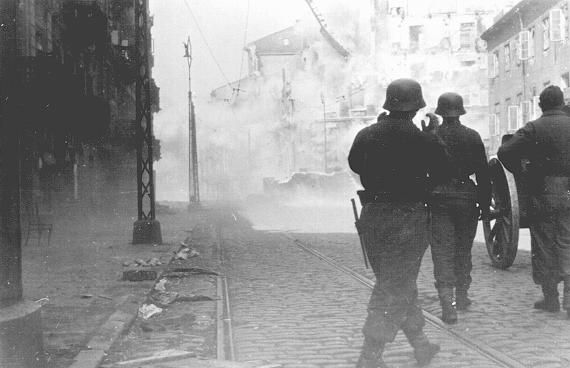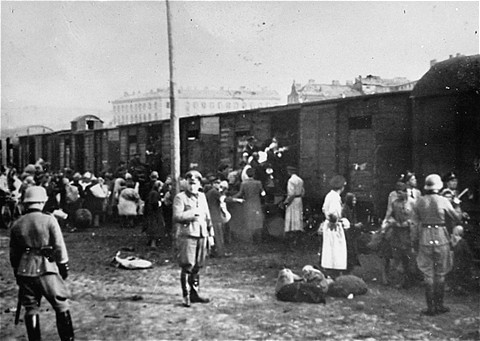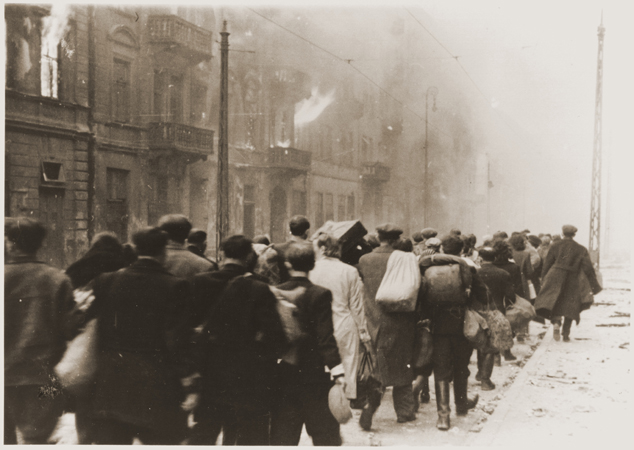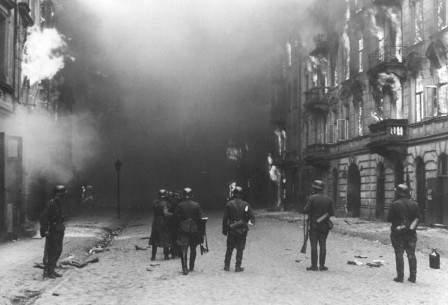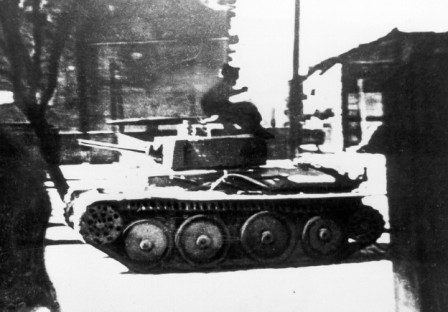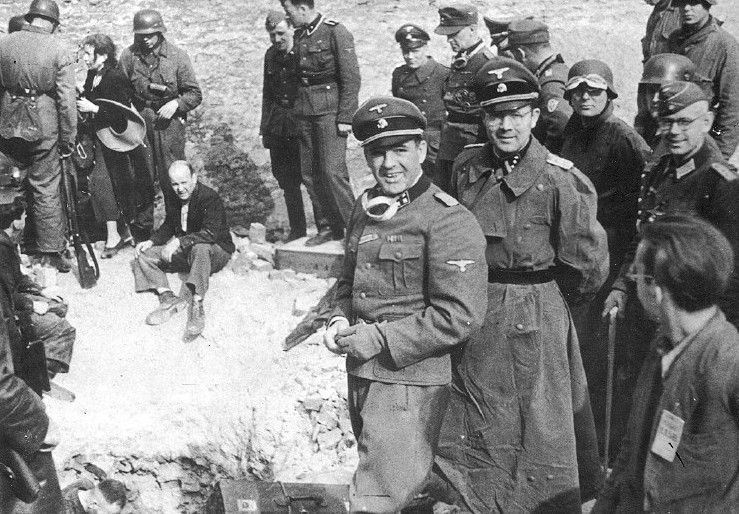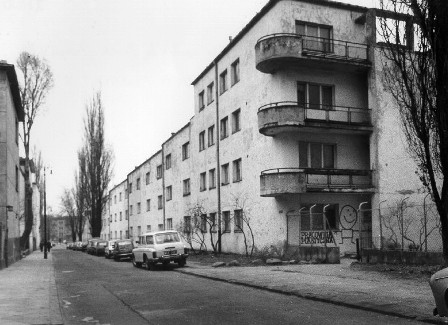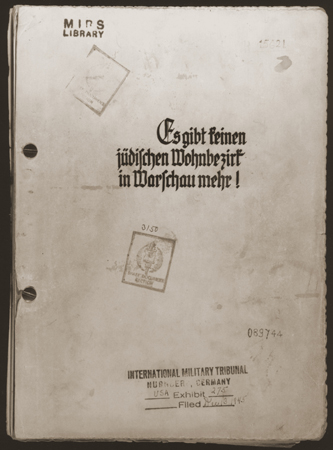Holocaust Education & Archive Research Team |
Revolt & Resistance
Acts of Resistance
Jewish Resistance
Groups Jewish Resistors Allied Reports Anti-Nazi Resistance Nazi collaborators
| |||||||||||
Battle for the Warsaw Ghetto
Report from the Jewish Workers Underground Movement 22 June 1943
A characteristic trait of this new extermination campaign waged by the Germans against the Jews is armed resistance on the part of the Jews. During the previous wave of extermination such acts of armed resistance were seldom dared. Once in a while we would receive word about such desperate deeds from one small town or another. Now the entire situation has changed radically. The leading role is being played by the Ghetto of Warsaw.
The first clashes on the streets of the Warsaw Ghetto occurred from 19 until 23 January 1943. That was the beginning of the battle between the armed German Police, SS men and the Jewish Armed Resistance Organisation, which made its first appearance at that time. The January clashes were an embarrassing surprise for the Germans, and were very promising for the future – a prelude of events to come.
Unfortunately lack of space prevents us from describing the historic events that occurred in the Warsaw Ghetto after the January clashes with the precision and esteem that even the smallest detail deserves. This must and shall be done at some future date.
The fight between the Jews and Germans in April and May 1943, that which has been termed the “Battle of Ghettograd” (Ghettograd – reminiscent of the stubbornness of Stalingrad), eclipses everything that has ever occurred in the annals of the Jews or any other people. The methods and means of the fighting, forced on the belligerents by the special circumstances in the Ghetto, varied in accordance with the various phases of the Battle.
The heart-breaking picture of the Ghetto in flames – shrouded in smoke, the noise of machine guns, cannons, field artillery, mine explosions, the destruction of blocks of buildings, the hell that was unleashed on our people – will forever remain in our memory. No man of letters, no painter will ever be able to recreate the greatness of the events we witnessed, nor the emotions that overwhelmed us during those tragic and historic days.
The Battle that began on 19 April lasted about a month, however, even at the end of May there was still some resistance.
The backbone of the entire battle was the Jewish Armed Resistance Organisation, which led the people into the fight. The organisation is the armed body of the Co-ordinating Committee, which comprises an equal number of representatives of the Bund and the Jewish National Committee. Neither the Revisionists (a Zionist Group), nor the Agudah (religious Jews) belonged to the Jewish Armed Resistance Organisation.
The Revisionists organised a small “Organisation for vengeance,” of their own which ceased to exist after the second day of the Battle. Workers and youth formed the majority in the Jewish Armed Resistance Organisation. The youngest was Lusiek, thirteen years of age, a member of the Bund youth group, Skif the oldest member of the organisation was forty.
All the members of the resistance organisation were idealists, adherents of various political trends. Their fraternity in battle (Bundists, Chalucym, Shomrim and others) was exemplary. The general attitude of the inhabitants of the Ghetto towards the idea of resisting the Nazis changed radically from what it was a year ago.
It would be wrong and unjust to presume that the heroic spirit and determination of the defenders of the Ghetto was but a result of despair. Many a fighter had ample opportunity to rescue himself by leaving the Ghetto. However, the fighters were full of a noble sense of duty, a soldier’s duty, of a powerful desire to carry on the fight for honour, for human dignity.
They were anxious to take revenge on Fascism, on the enemy of their people, on the enemy of mankind. The precautions of the Germans bordered on cowardice. The prolonged heroic resistance of the Ghetto banished the legend of the invincibility of the German Army, showed the Polish nation its vast possibilities in resisting the Nazis and strengthened its self-reliance. The “Jewish – German War” lent strength to the splendid spirit of resistance against the Germans, with which the Polish Underground had already been marked.
Being perfectly aware of this situation, the Germans gave vent to their rage and fury by turning the entire Ghetto into one mass of ruins. On the fifth day of the Battle, the Jewish Armed Resistance Organisation published a manifesto addressed to the Polish Underground, and to the inhabitants of our capital, conveying greetings from the Jewish Underground fighters.
Various sectors of the Polish Underground Labour Movement immediately responded with messages of solidarity and admiration. On the whole, the attitude of the Polish Underground towards the Battle of the Warsaw Ghetto was marked with respect for the fighters and with esteem for their daring.
However, this attitude varied in accordance with the different viewpoints on the Jewish problem of the various parts of the Polish Underground. The capital city of Poland, as well as the entire country, seethed with excitement because of the Battle of the Ghetto.
During the Battle the Co-ordinating Committee of the Bund and the Jewish National Committee issued daily communiqués on the Battle, which appeared in Polish clandestine publications and were broadcast abroad by the Polish clandestine radio station Swit.
The result of the Battle was: several thousand Jews were killed, burnt alive, suffocated by gas and about twenty-five thousand were deported to the concentration camps of Trawniki, Poniatow, Majdanek and Lublin.
Only the ruins of buildings, destroyed by mines, cannons and fires remain where the Ghetto once stood. The Warsaw Ghetto is now one big cemetery. Somewhere in the catacombs hundreds and perhaps thousands of those who survived the battle are still living in agony.
Only two days ago, for example, a thirteen – year old boy appeared from this subterranean world with a message dated 10 June, informing us about “life” in the modern catacombs. The entire bombardment of Warsaw in 1939 caused the destruction of 75,000 homes, while the present Battle of the Warsaw Ghetto ended with the destruction of one hundred and several thousand homes.
As for German casualties: more than one thousand were killed or wounded and tremendous material losses were suffered by German war production enterprises that were set on fire and destroyed by the Jewish Armed Resistance Organisation.
The casualties suffered by the Resistance Organisation were comparatively small, but many of its best members, including its commander-in-chief M. Ordche – Hashomer, Engineer Klepfisz, Armament Chief and Berek, both members of the Central Committee of the Bund, fell in the fight.
When various detachments of the Jewish Armed Resistance Organisation that struggled separately in different sections of the Ghetto were compelled to cease fighting, mainly because they had run out of ammunition, they tried to reach the outlets of this Hell.
At that time some two hundred members of the organisation were still alive. The first messenger who brought us word about the desperate struggle of the remnants of the organisation was Frydrych, a member of the Bund, who was prominent in our pre-war athletic organisation, Jutrznia. A former soldier in the Polish Army, he was a man of unusual bravery and courage.
Not long after he accomplished his mission, he together with a detachment of fighters of the Resistance Organisation, was captured by the enemy outside the Ghetto and shot. He made his last journey through subterranean channels to reach us, well aware of the importance of his task, and accomplished it against tremendous odds and under unusually dramatic circumstances.
These members of the Resistance Organisation who remained alive tried to get out of the Ghetto through underground channels and passages. It was a fantastic undertaking, accompanied by untold difficulties and danger.
Several detachments numbering some seventy people in all, managed to reach the forest under sensational circumstances. Several other detachments were caught by the Nazis, either at the outposts of the Ghetto or already outside of the Ghetto, but they died fighting until their last round of ammunition.
The remaining members of the Resistance Organisation, some sixty of them, did not manage to reach the outposts of the Ghetto and probably died in the underground channels, surrounded by the Germans.
The Warsaw Ghetto, as well as the others, has officially ceased to exist. An official statement, proclaiming the death penalty for all Jews and for anyone found sheltering them, speaks of the “former Jewish Ghetto.”
Now in the midst of a new wave of extermination, we are receiving urgent demands for weapons from the ghettos, however, we have very few left. That is why the resistance of the Jews is now not what it was in Warsaw.
There are places, however, where Jewish resistance to their Nazi oppressors is even more stubborn than before. The example set by the Battle of Warsaw Ghetto has influenced everyone. Unfortunately, circumstances prevented us from waging similar battles everywhere.
Warsaw 22 June 1943
CKRZMP w POLSCE
Second Report from the Jewish Workers Underground Movement
15 November 1943
A second report on Jewish resistance to the Nazis was written six months after the first. This was more wide-ranging, and included details of resistance elsewhere in Poland. Again what follows is excerpts:
4. CO-ORDINATING COMMITTEE
In July 1942, a committee was established in Warsaw to co-ordinate the efforts of our organisation (the Bund) with those of the Jewish National Committee. The new group’s activity in this regard has brought fruitful results (armed insurrections of January and April 1943).
Following complete liquidation of the Warsaw Ghetto, the activity of the Co-ordinating Committee embraced the entire sphere of material relief for the Warsaw Jews, and for all of Poland. This committee is neither a political body, nor a communal representation of the Jewish populace; it is merely a unit co-ordinating the activities of both organisations in the field of relief and struggle.
Paragraph two of the committee’s statutes states: “Political matters shall be settled by each Party in accordance with its world outlook.” Within the Co-ordinating Committee, we have been active in aiding the smaller cities and towns, along with the camps in the field of relief and preparation for armed rebellion.
We have assisted the Co-ordinating Committee with substantial sums for relief of Jews and non-Jews alike, who were active in the Relief Council for Jews, and had been arrested in their line of duty.
We have dispatched aid to various camps amounting to hundreds of thousands of zlotys. The Co-ordinating Committee has neither a treasury nor a treasurer of its own; however, all matters are aired, agreed upon, and unanimously decided upon by both parties.
In settling a number of committee matters, many of our comrades play an important part in trying and hazardous positions. The committee spokesmen have conferred with the official military representatives of underground Poland on preparation for the armed rebellion in the Warsaw Ghetto.
5. ARMED STRUGGLES
During the period covered in this report, a number of armed insurrections flared up around many centres. These struggles represent a continuation of the chain of heroic deeds which the Warsaw Ghetto initiated.
a) First of all BIALYSTOK. This is one of the cities which had, before the war, been strongly influenced by the Bund. The Jews of Bialystok put up fierce resistance when the Nazis began to liquidate the ghetto in mid-August 1943.
The armed rebellion lasted a month and was conducted with remarkable heroism. In Bialystok the Nazis again brought into play the methods and ammunition which they employed in Warsaw.
Nazi losses in the latter city were high, the Bialystok ghetto which numbered 30,000 – many of them victims of the uprisings – was liquidated. The surviving population was shipped to the Trawniki labour camp.
b) TREBLINKA. This death camp, where the Nazis annihilated hundreds of thousands of Jews, met total destruction at the hands of the Jews who had been enslaved there.
In the early part of August 1943, the revolting Jews slaughtered the entire 30-men Nazi guard unit that had patrolled the camp. They seized the ammunition, set fire to the buildings, destroyed all electrical communication lines, and blazed a path to the neighbouring woods. Two hundred Jews fled.*
c) Jewish rebellions on a smaller scale, occurred in TARNOW, BENDIN, CZENSTOCHOW, BORISLAW.
d) Heroism characterising the Treblinka revolt also marked the SOBIBOR rebellion. In Sobibor too, hundreds of Jews were murdered. The revolt which occurred in October 1943, culminated in the successful escape of a large number of Jews from that camp.
e) In conclusion I should like to cite the resistance which the Lodz Ghetto Jews have displayed on a number of occasions and which, while they were unarmed, was nevertheless intense and heroic. In February 1943, a general strike swept the Lodz Ghetto because of the launching of mass –executions by the Nazis. The strike was successful; the executions were halted.
I should also like to mention the Jewish camps of PONIATOW and TRAWNIKI, where armed rebellions, with the aid of the Co-ordination Committee and Jewish armed resistance organisation, which dispatched funds, ammunition and instructions to them, took place. Our comrades who, in the camps, comprise the greatest majority, are very actively preparing for the tasks ahead.
PARTISAN GROUPS
As I have already previously noted, in connection with ghetto liquidation, certain groups periodically flee to the woods and sometimes affiliate with partisan groups who they meet along the way.
We have devoted a great deal of attention to the matter of how to organise, link and unite these units. We have also discussed the problem at a number of meetings with spokesmen of the Polish underground military organisation.
MANIFESTO TO THE POLES
The following is the text of a manifesto addressed to the Poles, which was issued by the Jewish Armed Resistance Organisation during the first days of the Battle of the Warsaw Ghetto in April 1943:
“Poles,citizens, soldiers of Freedom!
Through the din of German cannons, destroying the homes of our mothers, wives and children; through the noise of their machine guns, seized by us in the fight against the cowardly German police and SS men; through the smoke of the Ghetto, that was set on fire, and the blood of its mercilessly killed defenders, we, the slaves of the Ghetto, convey heartfelt greetings to you.
We are well aware that you have been witnessing breathlessly, with broken hearts, with tears of compassion, with horror and enthusiasm, the war that we had been waging against the brutal occupant these past few days.
Every doorstep in the Ghetto has become a stronghold and shall remain a fortress until the end. All of us will probably perish in the fight, but we shall never surrender!
We, as well as you, are burning with the desire for vengeance. It is a fight for our freedom, as well as yours; for our human dignity and national honour, as well as yours! We shall avenge the gory deeds of Oswiecim, Treblinka, Belzec and Majdanek.
Long live the fraternity of blood and weapons in a fighting Poland.
Long live freedom
Death to the hangmen and the killer
We must continue our mutual struggle against the occupant until the very end.”
-Jewish Armed Resistance Organisation
It is fitting that on the anniversary of the Battle of the Warsaw Ghetto, we should supplement our previous reports with a detailed description of the activities of the Jewish Armed Resistance Organisation and of our own part in the armed resistance against the Nazis.
From the outset, the uprising was led by the Jewish Armed Resistance Organisation, which comprises Jewish Zionist elements as well as representatives of our Party.
Before relating the story of the Jewish Armed Resistance Organisation, we would like to outline our own situation and the circumstances which led to the establishment of this body.
You were informed through the report sent by Janczyn (one of the leaders of the Jewish Underground Labour Movement killed in action), that the first rumours about the mass extermination of Jews in gas chambers (Chlemno) reached the Jewish community of Warsaw in February 1941**
Our youth organisation Zukunft immediately called a meeting to discuss ways and means of defence should the mass slaughter of Jews spread throughout the General Government (the part of Poland occupied by Germany but not as yet incorporated in the Reich). The meeting unanimously decided to wage armed resistance. However, at that time, the layman did not believe the appalling truth of the un-heard of atrocities of the Germans.
The first conference of Jewish political parties to discuss the possibility of waging armed resistance did not take place until January 1942. The conference did not succeed in creating a Joint Armed Resistance Organisation.
The participants did not know each other well enough at that time and most of them were afraid lest information about the creation of such an organisation would reach the Germans and give them an excuse to further persecutions.
After this conference, our own Central Committee, at that time located behind the Ghetto walls, commenced organising a self-defence organisation consisting exclusively of members of our party. Its activities were strictly confidential.
From its inception, our self-defence organisation was in close contact with the Polish Socialist Organisation (RPPS). Three persons were appointed to lead our self-defence organisation (names cannot be divulged). Some of the officers of our self-defence detachments were: Abram Fajner, Frydrych Zalmen, Kostrynski Szmul, Lejbel Szpichlerz and Marek.
The members of our self-defence organisation received their military schooling from instructors of the PS (Polish Socialists). The most active members of the self-defence organisation were former members of our Skif and Zukunft (youth organisations of the Jewish Labour Movement before the outbreak of the war).
The names of the following persons, who are known to you, will give you an idea of the elements who joined our self-defence organisation: Jurek Blones, Janek Bilak, Gabrys Fryszdorf, Jankiel Gruszka, Natan Liebskiend, David Peltz, Weiwel Rosowski, Szperling, Pola Lifszyc (intelligence), Cywia Waks (intelligence) and others.
The most difficult task for us, who were shut behind the Ghetto walls and denied all contact with the world, was to provide our self-defence organisation with weapons. At that time no-one even dreamt of hand-grenades. To buy and hoard a sufficient number of pistols was difficult enough.
However, time passed quickly and soon we were confronted with a new situation. The deportation of the Jews from that part of Poland incorporated into Germany was almost completed. Only the Jews of Lodz were left there and the Ghetto of Lodz had become a closed concentration camp.
In the spring of 1942 the Germans had already commenced with the deportation of the Jews from the smaller towns in the General Government. Even a large Jewish community in one of the more important cities of Poland had already suffered a deportation, but the Jews of Warsaw still did not believe that the same horrible fate was in store for them too. They stubbornly insisted that the capital of Poland would be spared.
On 18 April 1942, the first flash of armed resistance occurred in the Ghetto. Our self-defence organisation paid dearly for its boldness. Our comrades Szklar (printer), Naftula Leruch, Mojsze Goldberg, Taube, Libder and Szajn (all well-known members of the Jewish Labour Movement, Bund), died as soldiers for freedom.
After these events there wasn’t a quiet night in the Ghetto any longer. Nevertheless, the layman still did not believe that a “22 July” would come – 22July was the fatal day on which the wholesale deportation of 500,000 Warsaw Jews towards death began.
Our Weker (the clandestine newspaper of the Jewish Underground Labour Movement) kept urging the Jewish population to resist. However, the Jewish police, together with the Jewish hirelings of the Gestapo as well as some of the elements close to the Kahal (Board of the Jewish Community) went out of their way to prevent an uprising of the Jews.
After 22 July 1942, while the deportation of the Jews of Warsaw was being brutally carried out, a second conference of all Jewish political parties took place. Not being able to convince them, even at that time, to wage armed resistance, we issued an appeal of our own to the Jews of Warsaw revealing the truth about the dreadful fate that was being prepared for them by the Nazis and calling for armed resistance.
Lacking sufficient weapons, we called upon the Jews to resist with their bare arms. The following is a quotation from a leaflet issued at that time:
“Don’t let them snatch you. Defend yourselves even if only with bare hands.”
A page or two of the report, following this quotation, was apparently lost on its way from Poland, via London, to us. Despite all their efforts, our delegation in London was unable to find the lost pages.
The Jews still did not believe. Only when, on the sixth day of the deportation, Zalmen Frydrych (Zygmunt) returned after having followed a transport of Warsaw’s Jews who were being sent to the death camp of Treblinka, and publicised his story; only when other Jewish underground groups commenced writing letters to house committees relating the same terrible truth did a part of the Jewish youth of Warsaw finally begin to believe, although the majority of the Jewish population, particularly the older generation, even at that time, stubbornly refused to face realities, to recognise the truth.
Even at that time, if anyone mentioned armed resistance, the reply of those Jews was, “It will only provoke disaster for us all. They will deport every one of us. Don’t you know the beastly manner in which the Germans apply collective responsibility?”
After the first week of the deportation, the various identification papers, issued by all kinds of shops, factories and institutions were invalidated. The only untouchables left were the members of the Jewish Police.
Throughout the deportation, our self-defence groups were on the alert, ready to resist and to die. We expected the momentary arrival of a large transport of the long wished-for weapons. The “five member groups” of our Skif and Zukunft were mobilised, as well as all available Party members. Everyone waited impatiently for the promised weapons, but they did not come. We were finally compelled to demobilise our resistance groups.
It was of great import to us to provide the members of our defence organisation with means to escape deportation. We had not given up hope for an armed resistance, and they were our best fighters. We established close connections with the Polish Socialists who helped us substantially in our task to hide our future fighters.
Some of them were rescued four or five times from the Umszlag Platz (the deportation place where Germans gathered the doomed Jews). We want to mention comrades Marjan Merenholc, Olek Kasman, Jerzy Hertz and Mietek Domb, who especially distinguished themselves by rescuing our members from deportation by the Nazis. They willingly risked their lives whenever we needed them.
After the so-called cauldrons (we just don’t know what the “cauldrons” refer to), when such a tremendous number of our comrades perished, the Umszlag Platz was still in operation, although the deportations were temporarily stopped.***
We utilised this time to rebuild our own Resistance Organisation. We simultaneously again tried to contact the representatives of the ZKN (Jewish National Committee) in an effort to establish a mutual resistance organisation.
At the end of October 1942, a Co-ordinating Committee was appointed consisting of one representative of the ZKN and one of the Bund (Jewish Labour Movement of Poland). Our representative A. Blum died a soldiers death.
We also appointed our comrade X as our representative in the ZOB (Jewish Armed Resistance Organisation). At that time, the membership of our own resistance organisation became quite numerous. The trouble was we had so few weapons.
The officer in charge of our resistance detachment, which operated on the territory of the brush factories was Grylak and, the one who operated on the territory of Tebens (a German military production firm in Warsaw), was Szloma Paff. ****
We had resistance detachments assigned to all other territories, but they had no firearms. The small number of such weapons, which we finally received in December 1942, from the Underground Polish forces, couldn’t satisfy even a fraction of our needs.
Two attempts to assassinate the chief of the Jewish Police, Jacob Leikin, and the liaison officer with the Germans, Israel First, lent popularity to the ZOB. The Jews already knew the truth about Treblinka and consequently no longer trusted the German denials.
The Jewish masses finally understood that their death verdict had been signed and that their only hope to rescue themselves was armed resistance against the murderer, and passive resistance of those among them who were unarmed.
Some people in the Ghetto dug hiding spots for themselves in order to escape deportation by the Germans, which was bound to start again sooner or later. The ZOB simultaneously began liquidating hirelings and servants of the Jewish Police and the Gestapo.
Members of our Party, outside of the ZOB, were of great help in the work of cleansing the Ghetto of the above-named elements. However, we were still not entirely prepared to meet the second deportation of the remnants of the Warsaw Ghetto by the Germans.
We had already received weapons at that time. The trouble was that they were not yet distributed among the members of the ZOB. The weapons were still stored in our clandestine Central Warehouse. That is why only the resistance groups located in the vicinity of this Warehouse were able to wage armed resistance. During the days of those first flashes of armed resistance, Abraham Fajner, our faithful comrade, died in action.
Although the armed resistance waged at that time, in January 1943, did not embrace the entire ghetto, because of the mentioned circumstances, and was confined to a rather small section of it, the significance of this first attempt can hardly be overestimated.
During the first armed battle against the Germans, the legend of an invincible German, holding the life and death of hundreds of thousands of Jews in his hands, vanished. Our fighters concentrated in five spots, mainly waged guerrilla warfare against the Germans. Nevertheless several more important battles took place.
The biggest battle broke out on the corner of Zamenhofa and Stawki Streets. The Germans totally surprised by the armed resistance of the Jews, stopped the deportation after two days. This unexpected success greatly increased the prestige and the role of the ZOB.
The authority of the ZOB (Jewish Armed Resistance Organisation), after the January battles, grew steadily from day to day. At that time, the ZOB governed the entire life of the Ghetto. For example, at the request of the ZOB, the Jewish Community Council contributed one million zlotys towards the sole purpose of buying weapons. This amount was paid in cash within a period of three days.
Being unable to perform their planned deportation of the Warsaw Jews by means of lies and false promises, the Germans finally resolved to deport the remaining Jews forcibly.
On 19 April 1943 at two o’clock in the morning, the Germans surrounded the Ghetto walls with many guards (every 25 meters) consisting of German, Ukrainian, and Latvian Fascist soldiers. Carefully, in singles, in twos and threes, the German soldiers entered the Ghetto.
But this time we were prepared. At four o’clock, before dawn, all our resistance groups were mobilised and at their assigned positions. They were prepared to meet the hated enemy. The number of armed resistance detachments were: eight in the centre of the Ghetto, five in the territory of the brush factories and seven in the vicinity of the big Schultz and Tebens factories.
At six o’clock in the morning, on 19 April 1943, 2000 armed SS men along with tanks and cannons, three trucks loaded with ammunition and an ambulance entered the Central Ghetto. The entire German deportation staff followed the SS army.
Among the members of this deportation staff were the following officers of the Gestapo and SS: Michalsen, Handke, Hoffle, Mireczko, Bareczko, Brand and Mende.*****
There were no Jews to be seen anywhere, all of them were hidden in subterranean, previously prepared trenches and holes of all sorts. Only the members of the ZOB remained on the surface and were on the alert. Our fighters were concentrated to defend three strategic points, barring entry into the main street of the Ghetto.
The first armed battle took place on Nalewki Street where two resistance units, behind barricades, defended the street. The battle there lasted six hours and brought about the first defeat of the Germans.The Germans retreated, leaving behind many of their soldiers who had been killed.
Simultaneously the main battle raged on the corner of Zamenhofa and Mila Streets. Our fighters, after building barricades to shut off the four corners of those streets, daringly attacked the main German detachment, which had entered the Ghetto. After the first salvos from machine-guns and hand-grenades were successfully aimed at the compact ranks of SS men, the entire street was deserted. The green uniforms of the Germans were no longer to be seen anywhere. They took shelter in nearby stores and gates and exchanged some shots with the defenders of the Ghetto.
After a cessation of fifteen minutes, tanks appeared. They came quite close to the spot where our fighters were gathered. After a while, incendiary bombs, calmly and carefully aimed, set the first tank on fire. The flames spread with unexpected swiftness and soon there was an explosion. The tank was lost. The other tank immediately left, together with the panic –stricken Germans.
Their retreat was covered with renewed gunfire and grenades. The German casualties numbered 200, killed and wounded. We lost only one soldier. After two hours, the Germans brought cannons, which were placed outside of the Ghetto, and successfully bombed the spot of their previous defeat. They took our defence strongholds, and freed the entrance into the Ghetto.
Suddenly, from the windows of the other side, Zamenhofa 29, grenades were thrown. This was the second attack against the Germans, which was being carried out on the same place by one of our resistance groups that had deliberately not participated in the previous battle, lest its whereabouts should be discovered.
Fifty Germans were killed, our group escaped without any casualties. At five in the afternoon, there were no longer any Germans in the Ghetto. They left the Ghetto in order to gather somewhere on a deserted territory nearby. Our temporary success had been a result of the suddenness and quickness of our resistance, performed from well-disguised spots.
The second day of the Battle of the Warsaw Ghetto, 20 April 1943, began with a large concentration of SS detachments, along with artillery, on the territory between the Ghetto and the Aryan districts (Plac Krasinskich).
However, they had not yet dared enter the populated Ghetto streets. At about three o’clock in the afternoon, a detachment of 300 SS men arrived near the gate to the district of the brush factories. They stopped for a little while, but this brief pause was sufficient for our fighters to cut an electric wire, which caused a mine explosion under the very feet of the SS men. The Germans ran away, leaving 80 to 100 killed and wounded. Only after two hours did they come back.
After the previous costly experience, they were now more careful and alert. Thirty SS men entered the gate to this district. Our fighters, hidden in selected spots, waited for them. Grenades and incendiary bombs met the Germans. Only two of the 30 SS men escaped. Those who were not hit by grenades burned alive.
But now the Germans brought their artillery into the battle. The district was shelled from all four sides. In the meantime, two high officers from the SS came into this district. They appealed to our fighters to put down their arms and proposed a fifteen minute truce.
Our fighters replied with more gunfire. From the other side of the district, somewhere near Franciszkanska Street, a second detachment of SS men tried to reach our fighters. Met by several well-aimed shots, this detachment gave up also and turned back. Once more the entire district was clean of Germans. That was the second complete victory for our fighters.
On the same day, 20 April 1943, in the vicinity of the large Schultz and Tebens factories, the Germans called upon the Jews to volunteer for forced labour camps, but their appeal was in vain.
All the inhabitants of this district, just as the inhabitants of the Central Ghetto, were hidden in subterranean caves. The management of Schultz and Tebens kept prolonging the time limit, in which the Jews could volunteer, but met with no success.
When the management of Schultz and Tebens declared that it was compelled to apply the same methods as in the Central Ghetto, our resistance groups that were concentrated in this district attacked a detachment of SS men with bombs and grenades somewhere on the Aryan side of the city, as well as the German detachments who were on their way to the Central Ghetto through Nowolipie and Smocza Streets. The Germans suffered 40 killed and many more wounded.
Executing a personal order issued by the Chief of the German Police in Lublin – Globocnik, who came to Warsaw to lead the Battle of the Ghetto, the Germans started setting the entire Ghetto on fire on the second day of the uprising. At first they set fire to the buildings and street blocks where they had suffered from our resistance – Nalewki 33, 35, 37, Mila 28,29, Zamenhofa 28 and finally, the entire district where the brush factories were located. This was the first large conflagration.
Thousands upon thousands of people perished in the flames. People were burned alive in their hide-outs as well as in their homes and on the rooftops. A jump from the third or fourth floor usually put an end to the lives of the burning Jews.
Those who succeeded in escaping the fire were shot on the street by the Germans. Many corpses were found in the sitting position. Those were people who had been killed while sleeping. A very common spectacle were corpses of women with children in their arms. In retaliation for the Ghetto fire, our fighters set fire to all the German Verterfassum stores (war materials collections), as well as to their large shops, which were worth millions of zlotys.
Conflagrations did not stop our resistance. The Germans hunted for our hide-outs. It was not difficult for the Germans to find them, because the terrible heat drove the Jews out of their hiding places, particularly at night, when they gathered in their backyards. They usually left traces leading to their hide-outs.
The Germans successfully employed the use of bloodhounds and sounding devices to find the hidden Jews. At that time our fighters had already dropped their offensive tactics and were on the defensive. Their task was to rescue, as far as possible, those who were still alive in their hide-outs. This task required a re-grouping of our armed forces.
Our detachments were now assigned to defend many of the still-existing hide-outs. On the sixth day of the Battle of the Warsaw Ghetto, 24 April 1943, defensive battles occurred in the territory of Schultz and Tebens.
Our fighters barricaded themselves in some buildings and on rooftops in an effort to prevent the Germans from reaching the hidden Jews. For many days our fighters defended the Jewish population that was in hiding. The bloodiest of these fights took place at Nowolipki 41, Leszno 78,76, 74, Nowolipie 67, 69.
All in all our offensive and defensive battles lasted ten days. Our meagre ammunition was alredy disappearing, the bits that were left were used exclusively for self –defence and guard duty.
According to our accounts the Germans suffered about 1200 casualties killed and wounded. Sporadic fights, waged by our fighters against the Nazis, took place long after the Battle of the Warsaw Ghetto was over. They occurred primarily at night. The Germans burned the Ghetto systematically. After two weeks the entire Ghetto, as well as the previously decimated districts ceased to exist. ******
Lack of water and food rendered impossible the life of those who still fought. The Germans then commenced burning down buildings. They hoped to destroy, together with the houses, the remaining dug-outs and nests of our fighters and to break their will to fight. The Germans used gas bombs.
During this final period of the last struggle against the Germans who invaded and seized our dug-outs, one after another, or suffocated the fighters by means of gas bombs, the majority of the ghetto defenders died.
A large number of the officers in charge of the Jewish Armed Resistance Organisation gathered in a special dug-out and committed suicide in order to escape from the clutches of the Germans. Only a small fraction of them was able to escape through the city’s sewers and reach the Aryan districts.
The four resistance groups that still remained in the Ghetto waged guerrilla warfare against the Germans for a month, all of the members of these four groups perished.
Thus the Battle of the Warsaw Ghetto lasted almost seven weeks.
Our Party was a member of the Jewish Armed Resistance Organisation for more than six months – from October 1942 until May 1943. We joined hands with all Jewish Zionist underground organisations. Our comrades lived and worked with the others just as members of a close family. A mutual aim united us.
During this entire of over half a year, there were no quarrels or struggles, which are common among adherents of different ideologies. All overworked themselves in organising the mutual defence of our dignity. All fought equally in this historic life and death struggle.
There was no difference between the members of our Party and the others in regard to sacrificing themselves or performing their soldiers duty until the very last. However, we are reporting here primarily about our own members.
At the beginning of the battle, in January 1943, we possessed four well- organised resistance detachments of our own. The officers in charge of them were: Jurek Blones, Welwel Rozowski, Lejwik Granzalz and Dawid Hochberg.
Our comrade X led the entire resistance of the brush factories’ territory. Our comrades who had been active before the January 1943 battles, were on the Co-ordinating Committee and the General Staff of the mutual Jewish Armed Resistance Organisation.
The following of our comrades were members of the Auxiliary Committee of the ZOB, located in the Aryan districts of Warsaw: Frydrych, S. Fund, Celemenski, Wladka- Peltel- Fajga. Michal Klepfisz led and organised the entire production of hand-grenades and incendiary bombs in the Aryan districts, as well as in the Ghetto.
The majority of all our fighters was killed in action, either in the Battle of the Warsaw Ghetto or immediately after reaching the Aryan districts through the sewers. Jurek Blones, who led our resistance group in the district of the brush factories was one of the most brilliant and gallant fighters.
Twice during the battle he rescued his detachment from sure death by alone engaging an entire detachment of attacking Germans. Mejlack Perelman, on his beat around the Ghetto walls, though wounded by three German shells, nevertheless for a long time covered the escape of his comrades, when he could no longer stand on his feet, he turned his gun over to one of his comrades, knowing how precious weapons were.
We took him to the backyard, near the dug-outs of his group, but he could not walk in. He was too weak, we carried him upstairs and put him in a certain room. When our man who was on duty called on him and wanted to help him, Perelman did not permit him to stay, “Take the rest of my weapons,” he said. “I cannot use them any more, but you will need them.” On the following day, the Germans set fire to the building he was in and he was burned alive.
Tobcia Dawidowicz, a liaison officer of our resistance group in the Schultz and Tebens territory, though wounded in the leg, nevertheless successfully led her group towards the sewers in order to help them escape. Not wanting to become a burden to her comrades, she remained in the Ghetto after all her comrades had entered the sewers.
Dawid Hochberg was an officer in charge of a resistance detachment in the Central Ghetto. When the Germans discovered the dug-out of his comrades, he handed his gun over to one of them and barricaded the entrance into the dug-out with his own body. It took the Germans 15 minutes to remove his body from the small entrance. In the meantime, the fighters of his group, along with other Jews that were hidden in the cave, escaped through another exit.
We can relate many other stories such as these about our fighters who struggled and died as heroes. Those comrades who functioned as collaborators with the ZOB during the Battle of the Warsaw Ghetto also died. They were: Luzer Klog, Grylak , Kiersz, Bluma Klog, Renia Pizyc and many others.
The Jewish Armed Resistance Organisation continues activities even now, after the Battle of the Warsaw Ghetto, establishing new contacts and maintaining old ones. Our representative is still on the General Staff of this organisation and in the Co-ordinating Committee which supervises its work.
The representative of our Party in the Aryan district branch of the ZOB, who was in contact with military and civil authorities of Underground Poland in conjunction with the entire existence of the Warsaw Ghetto was comrade …..
In July 1943, the Co-ordinating Committee appointed two of its members for the same purposes, one in behalf of our Party, the other in behalf of the ZK (Jewish National Committee).
The ZOB now has several detachments, one of which is active in Warsaw. The others are located in various country places, our comrades, who were put at the disposal of the ZOB, are the messengers who always contact the detachments in the country and provide them with money, clothing, medicaments, letters and weapons.
One can guess what a difficult and dangerous job it is to maintain such contacts. The ranks of the armed detachments of the ZOB are today sparser because of the counter-measures applied by the Germans and the activities of certain vicious bands (we don’t know what kinds of bands the report refers to). In general, the task of maintaining our contracts with the country is growing more and more difficult.
Notes:
* The revolt at the Treblinka death took place on the 2 August 1943 and 200 Jewish inmates escaped. However, only one German Kurt Kuttner was wounded, and no German was killed. Some Ukrainian guards were killed, but the ramp and the gas chambers were not destroyed, although many wooden structures were set on fire and destroyed.
** February 1941 should read February 1942 – Chelmno was not operational until the 8 December 1941
*** The cauldrons or Kessel in German was a “final” mass selection in a specified area north of Gesia and Franciszkanska Streets. Thirty thousand Jews were given numbers, their tickets to life, whilst some sixty thousand were deported to their almost certain death in Treblinka.
**** Schultz and Tobbens. Walter C Tobbens was one of the major German employers of over 10,000 Jewish workers in the Warsaw Ghetto; his factories produced military uniforms. He came to the Warsaw ghetto in 1939 after obtaining Jewish stores in Bremen.
***** Karl Georg Brandt and Gerhard Mende were members of the Warsaw Gestapo whilst the others mentioned came from the Aktion Reinhard deportation staff based in Lublin.
****** It is interesting to compare the Jewish estimates of German casualties as outlined in the infamous Stroop Report, Stroop records that only 15 German and Trawniki-manner died, and approximately 80 were wounded. Whether he decreased the numbers to disguise the casualties and provide a false picture, or the Jewish estimates are inflated, may never be verified.
Sources:
The Holocaust by Sir Martin Gilbert, published by Collins London 1986 Brave and Desperate by Ilan Kfir, Danny Dor, Chava Biran published by Beit Lohamei Haghetaot / Ghetto Fighters House Museum*& Second The Ghetto Fights by Marek Edelman, published by Bookmarks London, 1990 The Stroop Report published by Secker and Warburg London 1980 The Death Camp Treblinka by Alexander Donat published by the Holocaust Library New York 1979 In the Warsaw Ghetto by Stanislaw Adler, published by Yad Vashem Jerusalem 1982. Ringelblum, Emmanuel. Notes from the Warsaw Ghetto: The Journal of Emmanuel Ringelblum, Schocken Books, New York, 1974
Copyright Chris Webb and Victor Smart H.E.A.R.T 2011
|
